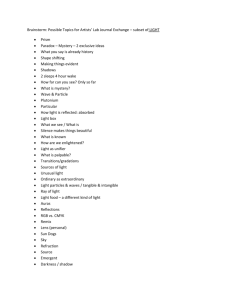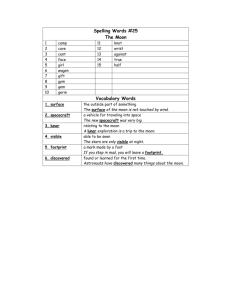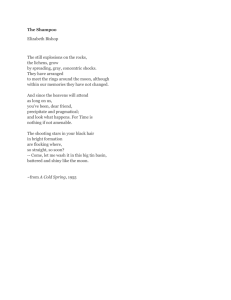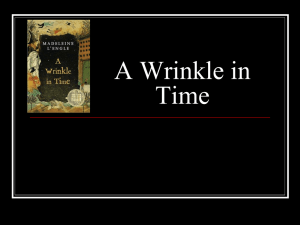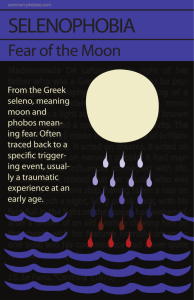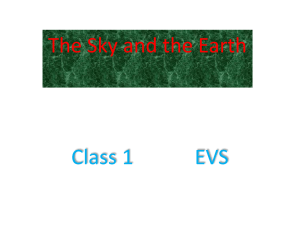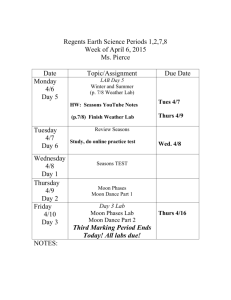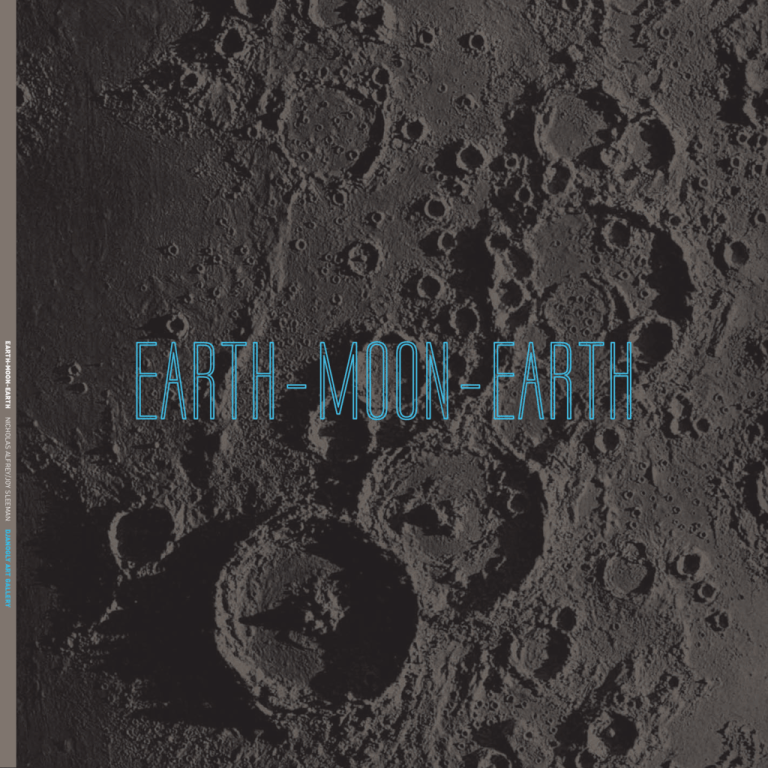
EARTH-MOON-EARTH
NICHOLAS ALFREY/JOY SLEEMAN
EARTH - MOON - EARTH
DJANOGLY ART GALLERY
06
Earth-Moon-Earth
(Moonlight Sonata Reflected from the Surface of the Moon) 2007
E.M.E. transmitter/reciever, Disklavier grand piano
Courtesy of the artist and Albion, London
Photo: © 2007 Katie Paterson
Installation view, Slade School of Fine Art, 2007
TRANSMISSION, REFLECTION
AND LOSS:
,
KATIE PATERSON S EARTH-MOON-EARTH
(MOONLIGHT SONATA REFLECTED FROM
THE SURFACE OF THE MOON)
BY NICHOLAS ALFREY
Katie Paterson’s installation Earth-Moon-Earth (Moonlight Sonata
than those usually transmitted, especially given that the five and a
Reflected from the Surface of the Moon) involves sending the first
half minutes or so it would take to play it on a piano are extended
movement of Beethoven’s famous sonata to the moon and back.
to three times as long once it has been transposed into Morse code.
The score has been translated into Morse code and transmitted
The returning signal from the moon was picked up by a receiver in
using E.M.E. (standing for the Earth Moon Earth, as in Paterson’s
Sweden, and the coded message reconstituted as a musical score
title), a method of radio communication in which radio waves
in ten sections by different anonymous participants. This
transmitted from earth are reflected back from the moon to an
collaborative aspect has been characteristic of Paterson’s work
earth-based receiver. The signals are then translated back into a
from the outset: the realization of her pieces has involved tapping
musical score, which is programmed for a player piano. But not
into various kinds of network of expertise or enlisting the help,
every note has survived its lunar journey, and subtle changes and
unconditionally given, of individual specialists.
i
losses now hobble the familiar melody.
What does it mean to send the ‘Moonlight Sonata’ to the moon?
The idea for Paterson’s piece began when she became aware of the
There is no suggestion of an equivalence between sound and
activities of ‘moonbouncers’, a network of mostly amateur radio
moonlight in Beethoven’s original conception of the piece: his
enthusiasts who specialize in sending messages to the moon. The
Piano Sonata Number 4 in C sharp minor opus 27 number 2 was
transmission itself was effected by the Southampton-based Peter
titled ‘Quasi una Fantasia’ when it was first published in 1802, and
Blair, a much respected moonbouncer, acting on instructions sent
only acquired its nickname thirty years later, after his death, when
by e-mail: this remoteness of the artist from the process of making
the poet Heinrich Rellstab said that the music reminded him of a
or action is entirely consistent with the protocols of a certain kind
boat passing the wild scenery of Lake Lucerne in the moonlight.
of conceptual art practice. The first movement of the moonlight
Arguably, this re-naming has already begun a process of
sonata (‘adagio sostenuto’) constitutes a much longer message
debasement in which Beethoven’s abstract musical values are
ii
07
08
collapsed into a conventional landscape evocation. The sonata can
still be regarded as the epitome of the Romantic spirit in music, but
the long afterlife of the piece has made it a cliché, and its capacity
to trigger the experience of authentic feeling is compromised by its
popularity, the endless ways in which it has been packaged and
commodified. It figures at the top of internet menus of moonrelated music, for example, and it is in this spirit that Paterson
selected it. She treats it as a found object, a debased cultural
artifact to be sent through space to encounter the ‘real’ moon in a
gambit that at first seems to suggest a sceptical attitude to the
whole idea of the Romantic sublime.
The mechanical, inexpressive character of the music as it is played
on the programmed Disklavier grand piano, produced by no visible
human agency, and further impeded by those missing notes,
There may be something uncanny in the sight of a piano played as
clearly runs counter to any idea of the great flights of the Romantic
if by an invisible performer, and something faintly absurd in the
imagination. By the same token, although the technologies that
sound of a much-loved melody, so steeped in romantic
have made it possible to send the score to the moon and back are
associations, rendered in such a strangely compromised and
quite remarkable, there is nothing spectacular in the way in which
inexpressive way, but there is much more at stake here than simply
they are presented in the installation itself. Paterson is an artist
a mockery of the aspirations of high romanticism and the
who is genuinely engaged with scientific ideas, but she is wary of
mythologies that have clustered around space travel. Paterson has
making any easy connections between, say, the tradition of the
spoken of her anxiety on exhibiting the piece for the first time that
sublime in western art and the hitherto unimaginable new domains
the effect would be merely comical, and her relief when, on the
revealed in fields such as communications technology or space
contrary, the modified score seemed to have acquired an additional
research.iii For all the daring scope of her projects and the
level of melancholy. There is something mysterious, too, in the
tenacious, problem-solving approach she brings to the realization
possibility that the gaps in the music might represent a sort of
of each new piece, her work has been invariably characterised by a
sonic negative image of the moon’s topography, with each missing
laconic, understated quality. It makes a continual play on the
note indicating some lunar crater or gulf in which the original
unexpected proximity of flatness and sublimity, the mechanical and
signal was lost.
the profound.
Earth-Moon-Earth
(Moonlight Sonata Reflected from the Surface of the Moon) 2007
E.M.E. transmitter/reciever, Disklavier grand piano
Courtesy of the artist and Albion, London
Photo: © 2007 Katie Paterson
Installation view, Slade School of Fine Art, 2007
Earth-Moon-Earth (Moonlight Sonata Reflected from the Surface of
At Nottingham, Earth-Moon-Earth is shown in a dialogue with David
the Moon) was first shown at Paterson’s MFA degree show at the
Lamelas’s seminal film of 1969, A Study of the Relationship Between
Slade School of Fine Art in 2007, along with Vatnajökll (the sound of),
Inner and Outer Space, bringing together two distinct phases of
a piece consisting of a telephone number in neon which gave
conceptual art, and framing both by an acknowledgement of the
anyone who called it access to a microphone embedded in a
fortieth anniversary of the Apollo 11 moon landing. Other artworks,
melting glacier in Iceland. Both works deal with time, distance and
objects and documents have been included in the exhibition to
communications technology, and both bring the everyday into
suggest some of the contexts in which the two main works might
contact with a remote world, whether on a global or cosmic scale.
be understood, ranging from memorabilia relating to the moon
Both were sufficiently low-key in their mode of presentation to
landing itself to artists’ books and other items indicating that the
mislead some people into thinking that here were examples of the
moon and outer space emerged as a compelling theme for artists
kind of art in which concept and proposition is everything, the
in the years around 1969, particularly for those associated with land
realization relatively undemanding. But the understated qualities of
art. There are also some items relating to earlier British artistic
the work conceal the formidable logistics and complex processes,
responses to the moon. These open up a way of working back from
not to mention significant costs and the endless necessity to raise
Paterson’s engagement with the idea of the connection between
sponsorship, that lie behind their making.
earth and space, and are introduced here to suggest that an oblique
and elliptical approach to this great theme has also been
The two pieces in the Slade show attracted an almost
characteristic of certain earlier endeavours.
unprecedented level of media attention. Paterson was invited to restage them at Modern Art Oxford in April 2008, this time in a
There have been several recent exhibitions that have dealt with
prestigious solo exhibition. One of the other gallery spaces was
aspects of the moon and the western artistic imagination. The most
devoted to the photographs of Anselm Adams; this meant that
ambitious was Cosmos: from Romanticism to the Avant-Garde, held at
iv
visitors had the opportunity to compare directly Paterson’s deadpan
the Montreal Museum of Fine Arts in 1999; it included sections
engagement with the themes of the moon and Icelandic glaciers
devoted to geological views, the polar icecaps and imaginary
with the work of one of the acknowledged masters of sublime
cosmologies as well as the moon itself.v The lunar section consisted
landscape. The contrast goes even deeper than first appears:
mainly of photographs, some derived from NASA, with Vilja
Adams had been trained as a pianist and believed that there was an
Celmins’s graphite studies of moon surfaces and galaxies
analogy between the photographic negative and the musical score,
representing the avant-garde. Two historical exhibitions addressed
and his most celebrated photograph is an image of moonrise. The
the theme of moonlight in north European Romantic painting, both
Oxford exhibition of Earth-Moon-Earth, therefore, served to
built around significant recent acquisitions by their host institutions:
underline the piece’s oblique and ambiguous relationship to the
Caspar David Friedrich: Moonwatchers at the Metropolitan Museum of
romantic tradition, making use as it does of second-hand elements
Art, New York in 2001 and Moonrise Over Europe: J.C. Dahl and
– the ‘Moonlight Sonata’ – in order to sidestep any obvious
Romantic Landscape at the Barber Institute of Fine Arts in 2006.vi The
overtones of grandeur or portentousness.
Starry Messenger: Visions of the Universe at Compton Verney (2006),
by contrast, dealt mostly with contemporary art, though it opened
with a display of the text from which the exhibition title derived,
Galileo’s Sidereus Nuncias, published in 1610.vii
09
One artist was common to all these exhibitions: John Russell
great moonlight subjects - the Colosseum and the Venetian Lagoon
(1745-1846), and it is entirely appropriate that he also figures in the
- perhaps in deliberate rivalry to the word pictures by Romantic
present exhibition at Nottingham. Russell was best known as a
poets such as Byron that were already widely celebrated. But he also
portrait artist, the leading exponent in eighteenth-century London
took an interest in the theories and speculations of scientists: he
of drawing in pastel, but he was also a notable amateur astronomer
owned a copy of Mary Somerville’s Mechanism of the Heavens, for
who succeeded in making a genuine contribution to knowledge in
example, and knew the author personally.
the field. He devoted forty years to the study of the moon, making a
long series of drawings and measurements, all of which fed into
Turner made Galileo’s villa at Arcetri the subject of one of the
the production of a large pastel portrait (or map?) of the gibbous
vignettes he produced to illustrate Samuel Roger’s Italy (1830), and it
moon, now in the Museum of the History of Science at Oxford,
has been suggested that a diagram of the solar system he included
though better known through the smaller version in Birmingham.
in a preliminary study for the design, propped up against the terrace
He also produced a large and spectacular engraving of the full
wall in front of the villa, might have derived from a conversation with
moon, published in 1805; it offered the most complete account of
Somerville.x In the final version chosen for engraving, there is a
lunar topography to date, and it has been said that ‘the highly
grouping of objects emblematic of astronomy in the foreground,
detailed nature and general accuracy of the image have never been
arranged as if in an open-air study: telescope, globe and open book,
surpassed’.
The small pastel of the full moon shown here is
though the diagram has gone.xi Galileo himself is not in the picture,
evidently related to this remarkable project. It is uncompromisingly
but then Turner always was the master of the absent hero, the empty
direct in attempting to make a ‘face painting’ (to borrow a common
chair, and in place of the astronomer we see his house, his vines, his
eighteenth-century way of referring to portraiture) of a celestial
accoutrements. The whole is flooded in moonlight, which is of course
body, surely the ultimate challenge to the goal of artistic objectivity.
both atmospheric scene-setting and the implied object of Galileo’s
The radiant disc inevitably contains far less topographical definition
enquiry (he was the first to attempt to make drawings of the moon).
than Russell achieved in the engraving, for as Patrick Moore once
The overall tone is almost impossibly romantic, as if in a tourist’s
warned the amateur astronomer, ‘full moon …is the very worst time
dream. We are back to the world of Heinrich Rellstab and his image
to start observing’. But in this case, and in spite of all the
of a boat crossing Lake Lucerne in the moonlight now so indelibly
perceptual difficulties, the artist is attempting to render the
associated with Beethoven’s sonata, an image dating to almost the
luminosity of the moon in its most spectacular phase.
same time as Turner was creating. (Turner, as it happened, would
viii
ix
make several paintings of moonlight on Lake Lucerne, a place
Russell was unique among artists in his direct and scientific scrutiny
Beethoven had never visited). He was quite comfortable with this
of the moon, though some of the many artists who were interested
kind of high-keyed, extravagant idiom, and he knew perfectly well
in the effect of moonlight were serious about getting the
that the Galileo design was destined for a drawing room table. But
astronomical conditions in their scenes right. Most preferred to use
this frankly commercial quality does not preclude an astute
moonlight to enhance already picturesque or poignant subjects,
approach to what might be called the scientific sublime. The
such as rocky coasts, harbours, and above all, ruins. (Paterson
seductive surface and layering of allusions in Galileo’s Villa are
would herself make moonlight the subject of a later work in her
combined with a shrewd awareness that some forms of knowledge
Lightbulb to Simulate Moonlight). Turner, in particular, took on the
can only be expressed obliquely.
Study of the Moon, John Russell c.1795. Pastel
Courtesy of Royal Astronomical Society Archives, London
11
Russell’s close account of the moon’s visible surface was not as
well known as it deserved to be, since the print was not widely
disseminated, but there was another notable attempt to bring the
moon to earth that proved more influential. James Nasmyth and
James Carpenter’s The Moon: Considered as a Planet, a World and a
Satellite, first published in 1874, is as striking for its oblique, artistic
qualities as for its scientific ambition. Nasmyth, the son of the
landscape painter Alexander Nasmyth, was an engineer by
profession, and is best known for his invention of the steam
hammer and for innovations in the design of the mounting of the
astronomical telescope. He had studied the moon for more than
thirty years, almost as long as Russell, and made a series of large
xii
drawings of its surface in black and white chalk. He made them the
basis for twenty-four plaster-of-Paris models, and it was these,
photographed in oblique light, that were used as the illustrations for
his book. The plaster models were a necessary intermediate stage
because it was not technically possible at this date to produce
photographs through a telescope that would have sufficiently high
definition to serve the didactic purpose Nasmyth and Carpenter had
in mind, a demonstration of the volcanic origin of lunar craters. The
resulting plates, it has been said, ‘make the book almost as much
xiii
a work of art as a piece of scientific literature’. These simulacra
are convincing enough to have shaped subsequent perceptions of
the moon’s topography, although they exaggerated relief and
rendered mountain ranges as too high and jagged. Mocking one
world up on another, this is a project that tends to blur distinctions
between material and distant domains.
Images from top:
Galileo’s Villa, Arcetri (Moonlight)
Chromolithograph after J.M.W. Turner, 1884
The Lunar Appenines, Archimedes, etc
from ‘The Moon: Considered as a Planet, a World, and a Satellite’
by James Naysmyth and James Carpenter.
London: John Murray, Albermarle Street, 1885.
13
Earth-Moon-Earth (4’33”) 2007
E.M.E. transmitter/receiver, postcard
Courtesy of the artist and Albion, London
Photo: © 2008, Ed Reeve
Installation view Albion, London 2008
Earth-Moon-Earth (4’33”) 2007
E.M.E. transmitter/receiver
Courtesy of the artist and Albion, London
Photo: © 2007 Katie Paterson
From Nasmyth and Carpenter’s ‘The Moon Considered as a Planet,
a World, and a Satellite’ it is a logical step back to Paterson, given
the role of the moon in her work as a passive communications
i Katie Paterson, Earth-Moon-Earth (Moonlight Sonata Reflected from the Surface of the Moon),
Oxford, 2008. The publication comprises the transcript of the Morse code as sent from earth and
as received from the moon, and the score as it was originally sent and received. It also includes a
CD playing the sounds of the Morse code as it returned to earth.
satellite from which a radio signal can be reflected. She has gone on
ii Sally O’Reilly, ‘Introducing Katie Paterson’, in Modern Painters, March 2009, pp.34-5. Other
to make one further piece utilizing the same ‘moonbounce’
information derives from a conversation with the artist in London on 26th May 2009.
technology, but with some subtle changes of implication due partly to
iii For a different view on the continuity of Romantic aesthetics and the findings of contemporary
the location from which the transmission was made, and partly to the
astronomy see Elizabeth Kessler’s contribution to David de Vorkin and others, The Hubble Space
Telescope: New Views of the Universe, National Geographic Books, 2004.
nature of the piece transmitted. Following the exhibition of EarthMoon-Earth at the Slade in the summer of 2007, Paterson won a
iv Encounters: Katie Paterson, Modern Art Oxford, 2 April-1 June, 2008. The other concurrent
exhibitions were devoted to Anselm Adams and Mircea Cantor.
scholarship to travel to Japan where she was able to experience the
custom of tsukimi or ‘moon watching’, traditionally associated with
the autumn full moon. This first-hand encounter with the longestablished cult of the moon in Japanese culture, with its moon-
v Jean Clair, ed., Cosmos: From Romanticism to Avant Garde, Montreal, 1999.
vi Sabine Rewald, Caspar David Friedrich: Moonwatchers, New York, 2001; Paul SpencerLonghurst, Moonrise Over Europe: J.C. Dahl and Romantic Landscape, London, 2006.
viewing castle towers and gardens with their raked gravel specially
vii The Starry Messenger: Visions of the Universe, Compton Verney, 2006.
designed to be experienced by moonlight, gave a new dimension to
viii See also Like the Face of the Moon, an exhibition curated by Brendan Prenderville for the
her existing concerns with long-distance radio communication and
South Bank Centre in 1991 dealing with objectivity in art.
networks of coded signals. Nevertheless, the main purpose of the trip
was to send a new message to the moon from a transmitter at
viii Ewen A. Whitaker, Mapping and Naming the Moon: A History of Lunar Cartography and
Nomenclature, Cambridge, 1999, p.98. See also W.F. Ryan, ‘John Russell and Early Lunar
Mapping’, in Smithsonian Journal of History, Vol. 1, 1966, pp.27-48.
Nagano-Ken. The result was Earth-Moon-Earth (4’33”), alluding to
John Cage’s composition of four minutes and thirty-three seconds of
silence.
ix Patrick Moore, Guide to the Moon, Guildford and London, 1976, p.218.
x John Gage, J.M.W. Turner: ‘A Wonderful Range of Mind’, New Haven and London, 1987, pp.222-4.
The preliminary sketch is reproduced in James Hamiliton, Turner and the Scientists, London,
1998, p.69. See also Jan Piggott, Turner’s Vignettes, London, 1993.
The shift from Beethoven’s Moonlight Sonata to Cage’s 4’33” is richly
significant: from romanticism to modernism, and from a found
musical object to an avant-garde work structured by an interval of
time but entirely open to chance. It was a symbolically appropriate
gesture to make a pilgrimage to Japan in order to transmit a canonical
xi The version included in the exhibition is a chromolithograph by M.H. Long published in a
portfolio of Turner’s vignette drawings by George Rowney, 1884.
xii Nasmyth received a medal from the Great Exhibition of 1851 for his series of drawings of the
lunar surface.
xiii William P. Sheehan and Thomas A. Dobbins, Epic Moon: A History of Lunar Exploration in the
work by an artist deeply influenced by the Japanese culture of Zen
Age of the Telescope, Richmond, Virginia, 1999, p.146. See also the online exhibition The Face of
Buddhism, and also a way of acknowledging Cage’s influence on so
of the exacting Woodburytype process used to reproduce the photographs, in which a lead relief
many aspects of contemporary art practice, ranging across
the Moon: Galileo to Apollo, Linda Hall Library. The entry (no.20) on Nasmyth’s book gives details
mould was made of each image. www.lindahall.org.
minimalism and conceptualism to time-based and performative
modes of working. It might be inferred from this shift in musical
‘message’ that the scepticism that had inflected the choice of sending
a romantic classic into space and back is no longer an issue. But it
must also be said that the Japanese interlude has helped to make
clear a latent romanticism that was always an element in Paterson’s
practice, already implied, perhaps, by her relief when the Moonlight
Sonata came back from the moon sounding sadder than ever.
Other illustrations taken from ‘The Moon: Considered as a Planet, a World, and a Satellite’,
Front cover: Theophilus, Cyrillus and Catahrina (detail)
Page X: Group of Lunar Mountains. Ideal Lunar Landscape.
Page X: Aspect of an eclipse of the Sun by the Earth as it would appear seen from the Moon
Back cover: The Lunar Appenines, Archimedes (detail)
15
This catalogue has been published in conjunction with the exhibition
40
EARTH - MOON - EARTH
20 June – 9 August 2009
Curated by Joy Sleeman of the Slade School of Fine Art, University College London and Nicholas Alfrey of the
Department of Art History at the University of Nottingham, and linked to the activities of an AHRC-funded
Research Network on Land Art and the Culture of Landscape, 1967-77.
Earth-Moon-Earth (Moonlight Sonata Reflected from the Moon) 2007 was presented at the Djanogly Art
Gallery courtesy of the artist Katie Paterson and Albion, London. A Study of the Relationships Between Inner
and Outer Space 1969 David Lamelas, and One 1971-2003 Ian Breakwell & Mike Leggett, were presented
courtesy of the artists and LUX, London.
Organised by Neil Walker, Visual Arts Officer, Djanogly Art Gallery
First published in 2009 by the Djanogly Art Gallery
Texts © Nicholas Alfrey and Joy Sleeman 2009
Copyright in all works by David Lamelas, Katie Paterson, Ian Breakwell & Mike Leggett resides with the artists
All rights reserved. No part of this publication may be reproduced, stored in a retrieval system or transmitted
in any form by any means mechanical, electronic, photocopying or otherwise, without the prior permission of
the publishers
ISBN 978-1-900809-66-5
Graphic design by Tom Partridge
Printed by Pyramid Press, Nottingham
Djanogly Art Gallery
Lakeside Arts Centre
University Park
Nottingham NG7 2RD
www.lakesidearts.org.uk
Inside cover illustrations:
Earth-Moon-Earth (Moonlight Sonata Reflected from the Surface of the Moon) 2007
Morse code sent to the moon and Morse code received from the moon
Katie Paterson


